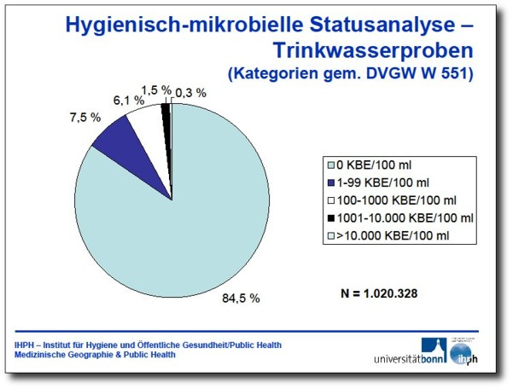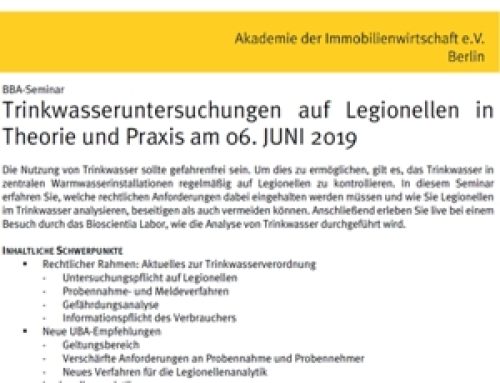Hygiene institute analyzes 1 million samples: 16.5% of buildings affected by Legionella, 0.3% of samples highly contaminated.
During this year’s water-related discussion conference of the German Technical and Scientific Association for Gas and Water (DVGW) in Essen, Professor Dr. Thomas Kistemann from the Institute for Hygiene and Public Health at the University of Bonn (ihph) presented the results of a nationwide status analysis on Legionella occurrence in drinking water installations for the first time to the public. More than 1 million drinking water data records were analyzed, yielding some surprising results in some cases.
Already at the end of 2014, the figawa working group “Drinking Water Analysis” commissioned the ihph to analyze and interpret a comprehensive dataset on the occurrence and distribution of Legionella in drinking water installations from a hygiene and microbiological perspective.
The results, which have been available since May 2015, were presented to the professional audience at the wat conference in October 2015. The ihph primarily investigated two questions:
- Do hygienically and medically relevant Legionella contaminations occur in (commercially used) drinking water installations in Germany under real conditions?
- Which risk factors are statistically associated with Legionella contamination?
The data provided by five drinking water control service providers from the middle of the working group were largely derived from routine sampling of commercially used buildings for Legionella. These data generally confirm the findings of previous publications on similar data collection efforts. Out of approximately 1,020,000 drinking water samples, 5.6% exceeded the so-called technical intervention level for Legionella of 100 colony-forming units (CFU) per 100 ml. Among the samples that were scientifically identified as clearly warm water (t> at or above 25 °C), the contamination rate is slightly higher at 6.5%. The statistics regarding the affected properties are interesting: 16.5% of the buildings were affected by Legionella, meaning that at least one sample exceeded the technical intervention level of 100 CFU. 6.1% of the buildings exhibited values ranging from 100 to 1000 CFU, 1.5% were classified as high (1001 – 10,000 CFU), and 0.3% were even classified as very highly contaminated (t >above 10,000 CFU). This corresponded approximately to the expectations of the working group, whose members, based on their own experiences, had assumed a target range of 12% to 18% of affected properties.
The influence of temperature during sampling and the maximum measured temperature at steady state (temperature stability) could be confirmed. The study indicates a highly significant correlation between these factors and Legionella concentration. An interesting partial result was also that the risk of Legionella proliferation in the temperature range below 55°C is three times higher than in the temperature range above 55°C. This finding confirms the recommendation of the DVGW guideline that, in circulating hot water systems, heat losses of more than 5 K compared to the storage outlet temperature of >=60°C should be avoided to ensure the hygienically sound operation of the system.
The study was naturally subject to certain limitations: the number and proportion of contaminated large-scale drinking water heating systems could not be determined based on the information on sampling and analysis, as an automated data export from the IT systems of the data providers was not possible. Due to the limited budget available for the study, manual selection and “facility-specific” assignment of samples was not carried out. This is intended to be the subject of another monitoring project. With scientific certainty, only approximately 500,000 water samples could be clearly assigned to hot water, distinguishing them from cold and mixed water.
Despite these limitations, the status analysis provides valuable insights into the influencing factors for Legionella concentrations in drinking water systems. One valuable insight is certainly that adhering to the DVGW guideline W 551 significantly reduces the occurrence of Legionella problems in drinking water systems. A detailed explanation of the study results can be found in an article by Prof. Dr. Kistemann and Dr. Sebastian Völker, published in the October 2015 issue of IKZ-Fachplaner. The article is available as a PDF download at this link.
IKZ-Fachartikel by Kistemann/Völker “Occurrence of Legionella in Drinking Water Systems”





